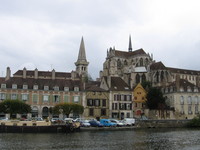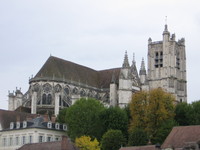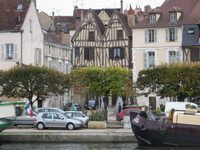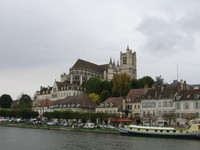Auxerre
 Lying between gay Paris and sombre Dijon, Auxerre with its 50,000 or so inhabitants is one of the main hubs in the wine-growing region of Burgundy. This deeply historical town has grown up on either side of the Yonne river and is dominated by the towering, gothic cathedral of Saint Etienne. Better known before for its role in the Hundred Years War and its trashing by the Protestant Huguenots, modern Auxerre has a top-flight football team and is much appreciated for its wine and its beautiful, provincial architecture.
Lying between gay Paris and sombre Dijon, Auxerre with its 50,000 or so inhabitants is one of the main hubs in the wine-growing region of Burgundy. This deeply historical town has grown up on either side of the Yonne river and is dominated by the towering, gothic cathedral of Saint Etienne. Better known before for its role in the Hundred Years War and its trashing by the Protestant Huguenots, modern Auxerre has a top-flight football team and is much appreciated for its wine and its beautiful, provincial architecture.
Attractions
 An early centre of Catholicism, Auxerre boasts a number of fine religious buildings. Top of the charts, is the Cathédrale Saint-Ãtienne dâAuxerre, first erected in 1215 on the site of a Romanesque cathedral. It wasnât until three centuries later, with setbacks due to the Hundred Years War and the War of Religions, that the Cathedral was completed and it now boasts an impressive, early roman fresco up in the vault, some beautiful bas-reliefs and various much lauded stained-glass windows. Its adjoined treasure-house also has a number of interesting and valuable medieval articles. Just as important in the townâs history is the Abbaye de Saint-Germain which dates back to the beginning of the 9th century. The abbey is still in extremely good condition and its crypts are decorated with the oldest mural paintings yet to be found in France. In comparison, the 17th century Church of Saint-Eustace is a far more modern affair, worth visiting for its rich decor and classical heritage.
An early centre of Catholicism, Auxerre boasts a number of fine religious buildings. Top of the charts, is the Cathédrale Saint-Ãtienne dâAuxerre, first erected in 1215 on the site of a Romanesque cathedral. It wasnât until three centuries later, with setbacks due to the Hundred Years War and the War of Religions, that the Cathedral was completed and it now boasts an impressive, early roman fresco up in the vault, some beautiful bas-reliefs and various much lauded stained-glass windows. Its adjoined treasure-house also has a number of interesting and valuable medieval articles. Just as important in the townâs history is the Abbaye de Saint-Germain which dates back to the beginning of the 9th century. The abbey is still in extremely good condition and its crypts are decorated with the oldest mural paintings yet to be found in France. In comparison, the 17th century Church of Saint-Eustace is a far more modern affair, worth visiting for its rich decor and classical heritage.
 Walking around the narrow streets in the centre of Auxerre, itâs easy to imagine what the medieval town was like, not least given the town housesâ timbered façades. Apart from the statues of famous Auxerrois dotted here and there, the main attraction in the centre is the Tour de lâHorloge, a gothic-style tower whose clock is renown for having sun and moon ended hands which map out their respective journeys through the sky. The wheels and cogs which keep all this going can be seen in one of the adjacent rooms. Otherwise, the Maison du Coche-dâEau and the Place St Nicolas are picturesque and worth a visit, while the townâs Natural History Museum has a large collection of fossils, archaeological remains and stuffed animals.
Walking around the narrow streets in the centre of Auxerre, itâs easy to imagine what the medieval town was like, not least given the town housesâ timbered façades. Apart from the statues of famous Auxerrois dotted here and there, the main attraction in the centre is the Tour de lâHorloge, a gothic-style tower whose clock is renown for having sun and moon ended hands which map out their respective journeys through the sky. The wheels and cogs which keep all this going can be seen in one of the adjacent rooms. Otherwise, the Maison du Coche-dâEau and the Place St Nicolas are picturesque and worth a visit, while the townâs Natural History Museum has a large collection of fossils, archaeological remains and stuffed animals.
Heading out of Auxerre, the informative Maison de lâEau et de lâEnvironnement is housed in an old water pumping station and highlights the importance of preserving the natural environment. Still in the region of Yonne, its well worth visiting the hilltop town of Vézelay, part of which is a UNESCO listed site. The town was important on the pilgrim route and has a lot of beautiful religious architecture. Further a field, the Abbaye de Cluny once had the largest church in the whole of Christendom and was hugely influential during the whole medieval period. Though much of the Abbey was dismantled after the Revolution of 1792, what remains is impressive and gives a breathtaking indication of quite how big the Abbey once was.
 The region around Auxerre is superb for walking, whether you follow one of the GR 13, GR 213 or GRP Restif de la Bretonne routes or do a walk of your own through the forests, vineyards and orchards that surround the town. AJ Auxerre, the local 1st division football team, are well worth catching and the atmosphere at the Stade Abbé Deschamps tends to be fun. Otherwise, look out for Auxerreâs various festivals, including the Festival de Piano and the popular film music festival.
The region around Auxerre is superb for walking, whether you follow one of the GR 13, GR 213 or GRP Restif de la Bretonne routes or do a walk of your own through the forests, vineyards and orchards that surround the town. AJ Auxerre, the local 1st division football team, are well worth catching and the atmosphere at the Stade Abbé Deschamps tends to be fun. Otherwise, look out for Auxerreâs various festivals, including the Festival de Piano and the popular film music festival.
Shopping
Both the region of Yonne and the region of Burgundy, of which the former is part, have gained international reputations for their wines and no trip to the area would be complete without visiting a few of the local vineyards and investing in a bottle or two of your own. Whether producing Chablis, Auxerrois or La Côte des Nuits, most vineyards welcome visitors, offer a dégustation and sell superb wine on-site.
Nightlife and Eating Out
Like most of the French, the Auxerrois value their food highly, so eating in and around Auxerre can be a real treat. The region counts amongst its exports Dijon mustard, crème de cassis liquor, kir, various kinds of ham, such as le jambon persillé, and snails, whilst excellent cheeses such as le soumaintrain and le saint-florentin are produced locally. Auxerreâs numerous restaurants cater for all budgets, with many within walking distance of the centre of town. The best of them offer the kind of gastronomic experience for which France is renown.
Tourist Information
Tel: +33 (0)3.86.51.03.26Email: ot.bis.auxerre@wanadoo.fr Address: 1 quai de la RépubliqueWeb: www.ot-auxerre.fr/Tourist-office.html
Airport
Given the proximity of Paris, Auxerreâs own small airport has yet to be developed. Paris Charles de Gaulle airport is about a two hour drive away, with flights to almost every conceivable international destination. For domestic flights, the options are either Paris Orly or Dijonâs airport, both about 90 minutes away by car. Note that regular trains leave for Paris and Dijon and connections are easily made to the respective airports.
Popular car hire locations in France
All car hire locations in France
- Abbeville

- Abbeville-Buigny-Saint-Maclou Airport

- Abidos

- Agen

- Agen-La Garenne Airport

- Agora Helipad Airport

- Aix-En-Provence

- Aix-Les-Bains

- Ajaccio

- Ajaccio-Napoléon Bonaparte Airport

- Albertville

- Albi

- Albi-Le Séquestre Airport

- Alençon

- Alfortville

- Alixan

- Alès

- Amboise

- Ambérieu-En-Bugey

- Amiens

- Amiens-Glisy Airport

- Ancenis

- Andernos-Les-Bains

- Angers

- Angers-Loire Airport

- Anglet

- Angoulême

- Angoulême-Brie-Champniers Airport

- Annecy

- Annecy-Haute-Savoie-Mont Blanc Airport

- Annemasse

- Annonay

- Antibes

- Arcachon

- Arcachon-La Teste-De-Buch Airport

- Argelers

- Arles

- Arras

- Ars-En-Ré

- Aubagne

- Aubenas-Ardèche Méridional Airport

- Aubergenville

- Auch

- Aulnay-Sous-Bois

- Auray

- Aurillac

- Aurillac Airport

- Auxerre

- Auxerre-Branches Airport

- Avallon

- Avignon

- Avignon-Caumont Airport

- Avoine

- Avranches

- Bagnolet

- Bailleul

- Bandol

- Bastia

- Bastia-Poretta Airport

- Bayeux

- Bayonne

- Beaulieu-Sur-Mer

- Beaune

- Beauvais

- Belfort

- Bellegarde-Sur-Valserine

- Bergerac

- Bergerac-Roumanière Airport
- Bernay

- Besançon

- Bezannes

- Bezons

- Biarritz

- Biarritz-Anglet-Bayonne Airport

- Biganos

- Billère

- Biscarrosse

- Blagnac

- Blain

- Blaye

- Blois

- Bobigny

- Boissy-Saint-Léger

- Bolquère

- Bondy

- Bonifacio

- Bordeaux

- Bordeaux-Mérignac (ba 106) Airport

- Boulogne-Billancourt

- Boulogne-Sur-Mer
- Bourbourg

- Bourg-En-Bresse

- Bourg-Lès-Valence

- Bourg-Saint-Maurice

- Bourges

- Bourges Airport

- Bourgoin-Jallieu

- Boves

- Brest

- Brest Bretagne Airport

- Briançon

- Brignais

- Brignoles

- Brive-La Roche Airport

- Brive-La-Gaillarde

- Béthune

- Béziers

- Béziers-Vias Airport

- Caen

- Caen-Carpiquet Airport

- Cagnes-Sur-Mer
- Cahors

- Calais

- Calais-Dunkerque Airport

- Calvi

- Calvi-Sainte-Catherine Airport

- Cambrai

- Camon

- Canet-En-Roussillon

- Cannes

- Cannes-Mandelieu Airport

- Carcassonne

- Carcassonne Airport

- Carentoir

- Carpentras

- Carros
- Castelsarrasin

- Castets

- Castres

- Castres-Mazamet Airport

- Castries
- Caudebec-En-Caux

- Cavaillon

- Cavalaire-Sur-Mer

- Cesson-Sévigné

- Chalon-Sur-Saône

- Chalonnes-Sur-Loire

- Chambray-Lès-Tours

- Chambéry

- Chambéry-Savoie Airport

- Chamonix-Mont-Blanc

- Chaponnay

- Charles De Gaulle International Airport

- Charleville-Mézières

- Chartres

- Chaumont

- Chauvigny-Du-Perche

- Chelles

- Cherbourg-Maupertus Airport

- Chessy-Les-Prés

- Chevilly-Larue

- Cholet

- Cholet Le Pontreau Airport

- Châlons-En-Champagne

- Châlons-Vatry Air Base Airport

- Château-Thierry

- Châteaubriant

- Châteaudun

- Châteauroux

- Châteauroux-Déols "Marcel Dassault" Airport

- Châtellerault

- Clermont-Ferrand

- Clermont-Ferrand Auvergne Airport

- Clichy-Sous-Bois

- Cluses

- Cognac

- Cognac-Châteaubernard (ba 709) Air Base Airport

- Coignières

- Colmar

- Colmar-Houssen Airport

- Colombes

- Compiègne

- Concarneau

- Corbeil-Essonnes

- Cordemais

- Corte

- Cosne-Cours-Sur-Loire

- Courchevel

- Courchevel 1550

- Courchevel Airport

- Creil

- Creil Air Base Airport

- Croisette Airport

- Créteil

- Dammarie-Les-Lys

- Dardilly

- Dax

- Deauville

- Deauville-Saint-Gatien Airport

- Decazeville

- Dieppe

- Digne-Les-Bains

- Dijon

- Dijon-Bourgogne Airport

- Dinan

- Dinard-Pleurtuit-Saint-Malo Airport

- Disneyland Paris Airport

- Dives-Sur-Mer

- Dole

- Dole-Tavaux Airport

- Dordives

- Douai

- Draguignan

- Dunkerque

- Egletons

- Els Banys D'Arles
- Eu

- Euroairport

- Euroairport Basel-Mulhouse-Freiburg

- Fain-Lès-Moutiers

- Figari Sud-Corse Airport

- Figeac

- Flers

- Fleury-Les-Aubrais

- Foix

- Font-Romeu-Odeillo-Via

- Fontainebleau

- Fontenay-Le-Comte

- Forbach

- Frejus Airport

- Fromentine

- Frontignan

- Fréjus

- Gap

- Gap - Tallard Airport

- Gevrey-Chambertin

- Ghisonaccia

- Gien

- Givet

- Gouesnou

- Gradignan

- Granville

- Granville Airport

- Grasse

- Gray

- Grenoble

- Grenoble-Isère Airport

- Gueugnon

- Guingamp

- Guéret

- Haguenau

- Ham-Sur-Meuse

- Heliport Airport

- Hendaye

- Hirson

- Hyères

- Hénin-Beaumont

- Issoire

- Jarnac

- Joigny

- Jonzac

- Juan Les Pins Airport

- Juan-Les-Pins

- L'Île-Rousse
- La Baule-Escoublac

- La Baule-Escoublac Airport

- La Chapelle-Saint-Luc

- La Ciotat

- La Croix-Valmer

- La Defense Heliport Airport

- La Ferté-Bernard

- La Flèche

- La Grande-Motte

- La Haie-Fouassière

- La Moncelle

- La Môle Airport

- La Palmyre

- La Plaine-Saint-Denis

- La Roche-Sur-Yon

- La Roche-Sur-Yon Airport

- La Rochelle

- La Rochelle-Île De Ré Airport

- La Seyne-Sur-Mer

- La Tranche-Sur-Mer

- La Tremblade

- La Valette-Du-Var

- La Vallée De Dormelles

- Landerneau

- Lanester

- Langon

- Lannemezan

- Lannion

- Lannion-Côte De Granit Airport

- Laon

- Laval

- Laval-Entrammes Airport

- Le Bourget

- Le Bouscat

- Le Cannet

- Le Cap D'Agde
- Le Creusot

- Le Havre

- Le Havre Octeville Airport

- Le Lavandou

- Le Luc

- Le Mans

- Le Mans-Arnage Airport

- Le Passage

- Le Pecq

- Le Puy-En-Velay

- Le Puy-Loudes Airport

- Le Touquet-Côte D'Opale Airport
- Le Touquet-Paris-Plage
- Lens

- Les Arcs

- Les Herbiers

- Les Mureaux

- Les Sables-D'Olonne
- Les Sables-D'Olonne Talmont Airport
- Les Ulis

- Lesparre-Médoc

- Levallois-Perret

- Libourne

- Lille

- Lille-Lesquin Airport

- Limoges

- Limoges Airport

- Lisieux

- Longwy

- Lons-Le-Saunier

- Lorient

- Lorient South Brittany (bretagne Sud) Airport

- Loriol-Sur-Drôme

- Lourdes

- Louviers

- Louvigny

- Louvroil

- Ludres

- Luisant

- Lumio

- Lunéville

- Lure

- Luxeuil-Les-Bains

- Luçon

- Lyon

- Lyon Saint-Exupéry Airport

- Lyon-Bron Airport

- Lys-Lez-Lannoy

- Lézignan-Corbières

- Macinaggio

- Magenta

- Maisons-Alfort

- Malakoff

- Manosque

- Mantes-La-Jolie

- Marans

- Marmande

- Marseillan

- Marseille

- Marseille Provence Airport

- Martigues

- Massy

- Maubeuge

- Mazamet

- Meaux

- Megève

- Megève Airport

- Melle

- Melun

- Menton

- Metz

- Metz-Frescaty (ba 128) Air Base Airport

- Metz-Nancy-Lorraine Airport

- Migennes

- Millau

- Mimizan

- Mimizan-Plage

- Mont-De-Marsan

- Montargis

- Montauban

- Montauroux

- Montbard

- Montbéliard

- Montchanin

- Montereau-Fault-Yonne

- Montigny-Le-Bretonneux

- Montluçon

- Montluçon-Domérat Airport

- Montpellier

- Montpellier-Méditerranée Airport

- Montreuil

- Montrouge

- Montélimar

- Montévrain

- Morangis

- Morlaix

- Morlaix-Ploujean Airport

- Morteau

- Morzine

- Moulins

- Mulhouse

- Mâcon

- Méribel

- Méribel Airport

- Mérignac

- Nancy

- Nancy-Essey Airport

- Nanterre

- Nantes

- Nantes Atlantique Airport

- Narbonne

- Neuilly-Sur-Seine

- Nevers

- Nevers-Fourchambault Airport

- Nice

- Nice-Côte D'Azur Airport
- Niort

- Niort-Souché Airport

- Nogent-Le-Rotrou

- Nogent-Sur-Marne

- Nogent-Sur-Oise

- Noirmoutier-En-L'Île
- Noisy-Le-Grand

- Nérac

- Nîmes

- Nîmes-Arles-Camargue Airport

- Olivet

- Orange

- Orgeval

- Orléans

- Orvault

- Oyonnax

- Paimpol

- Pamiers

- Paris

- Paris Beauvais Tillé Airport

- Paris Issy-Les-Moulineaux Airport

- Paris-Le Bourget Airport

- Paris-Orly Airport

- Parthenay

- Pau

- Pau Pyrénées Airport

- Perpignan

- Perpignan-Rivesaltes (llabanère) Airport

- Pertuis

- Pierrelatte

- Pierrelaye

- Pithiviers

- Ploërmel

- Poissy

- Poitiers

- Poitiers-Biard Airport

- Poligny

- Pont-Audemer

- Pont-à-Mousson

- Pontarlier

- Pontcharra

- Pontchâteau

- Pontivy

- Pontoise

- Pontoise - Cormeilles-En-Vexin Airport

- Pornic

- Porticcio

- Porto-Vecchio

- Pouldergat

- Pouzauges

- Prades

- Propriano

- Propriano Airport

- Provins

- Périgueux

- Périgueux-Bassillac Airport

- Quimper

- Quimper-Cornouaille Airport

- Rambouillet

- Ramonville-Saint-Agne

- Redon

- Reims

- Reims-Champagne (ba 112) Airport

- Rennes

- Rennes-Saint-Jacques Airport

- Revigny-Sur-Ornain

- Revin

- Riedisheim

- Rillieux-La-Pape

- Roanne

- Roanne-Renaison Airport

- Rochefort

- Rochefort-Saint-Agnant (ba 721) Airport

- Rodez

- Rodez-Marcillac Airport

- Roissy-En-Brie

- Romorantin-Lanthenay

- Roscoff

- Rouen

- Rouen Airport

- Royan

- Royan-Médis Airport

- Rueil-Malmaison

- Ruffec

- Ruffec, Charente

- Rungis

- Sagone

- Saint-Avold

- Saint-Brieuc

- Saint-Brieuc-Armor Airport

- Saint-Claude

- Saint-Claude-De-Diray

- Saint-Denis

- Saint-Dizier

- Saint-Dié-Des-Vosges

- Saint-Florent

- Saint-Florentin

- Saint-Gaudens

- Saint-Geoirs

- Saint-Georges-D'Oléron
- Saint-Germain-En-Laye

- Saint-Gilles-Croix-De-Vie
- Saint-Herblain

- Saint-Jean-D'Angély
- Saint-Jean-De-Maurienne

- Saint-Lô

- Saint-Malo

- Saint-Marcel-Lès-Valence

- Saint-Maur-Des-Fossés

- Saint-Nazaire

- Saint-Nazaire-Montoir Airport

- Saint-Omer

- Saint-Ouen

- Saint-Ouen-L'Aumône
- Saint-Pierre-Des-Corps

- Saint-Quentin

- Saint-Raphaël

- Saint-Savin

- Saint-Senier-Sous-Avranches

- Saint-Sulpice-Sur-Risle

- Saint-Thibault-Des-Vignes

- Saint-Tropez

- Saint-Vulbas

- Saint-Étienne

- Saint-Étienne-Bouthéon Airport

- Sainte-Maxime

- Saintes

- Saintes-Maries-De-La-Mer

- Sallanches

- Salon-De-Provence

- Santa-Lucia-Di-Moriani

- Sarlat-La-Canéda

- Sarre-Union

- Sarrebourg

- Sarreguemines

- Saumur

- Saverne

- Sedan

- Sens

- Serquigny

- Serre Chevalier Airport

- Seynod

- Soissons

- Solenzara

- Sommesous

- Sophia Antipolis

- Sophia Antipolis Airport

- Soulosse-Sous-Saint-Élophe

- St Aubin Airport

- Strasbourg

- Strasbourg Airport

- Sully-Sur-Loire

- Surgères

- Sète

- Sélestat

- Tarbes

- Tarbes-Lourdes-Pyrénées Airport

- Tavaux

- Tavers

- Thiers

- Thionville

- Thonon-Les-Bains

- Thouars

- Tignes

- Tinqueux

- Torcy

- Toul

- Toulon

- Toulon-Hyères Airport

- Toulouse

- Toulouse-Blagnac Airport

- Tourlaville

- Tours

- Tours-Val-De-Loire Airport

- Toussus-Le-Noble Airport

- Trappes

- Tresses

- Trignac

- Troyes

- Uzès

- Val-D'Isère
- Valence

- Valence-Chabeuil Airport

- Valenciennes

- Valentigney

- Valenton

- Valréas

- Vannes

- Vannes-Meucon Airport

- Varennes-Sur-Seine

- Vaulx-En-Velin

- Veauche

- Vendôme

- Verdun

- Vernon

- Versailles

- Vertou

- Vesoul

- Vichy

- Vichy-Charmeil Airport

- Vienne

- Vierzon

- Villefranche-Sur-Saône

- Villeneuve-D'Ascq
- Villeneuve-Loubet
- Villeneuve-Sur-Lot

- Viriat

- Viroflay

- Viry-Châtillon

- Vitrolles

- Vitry-Le-François

- Vitré

- Vélizy-Villacoublay

- Vénissieux

- Yutz

- Échirolles

- Écully

- Épernay

- Épinal

- Épinay-Sur-Seine

- Étampes

- Évreux

- Évry




